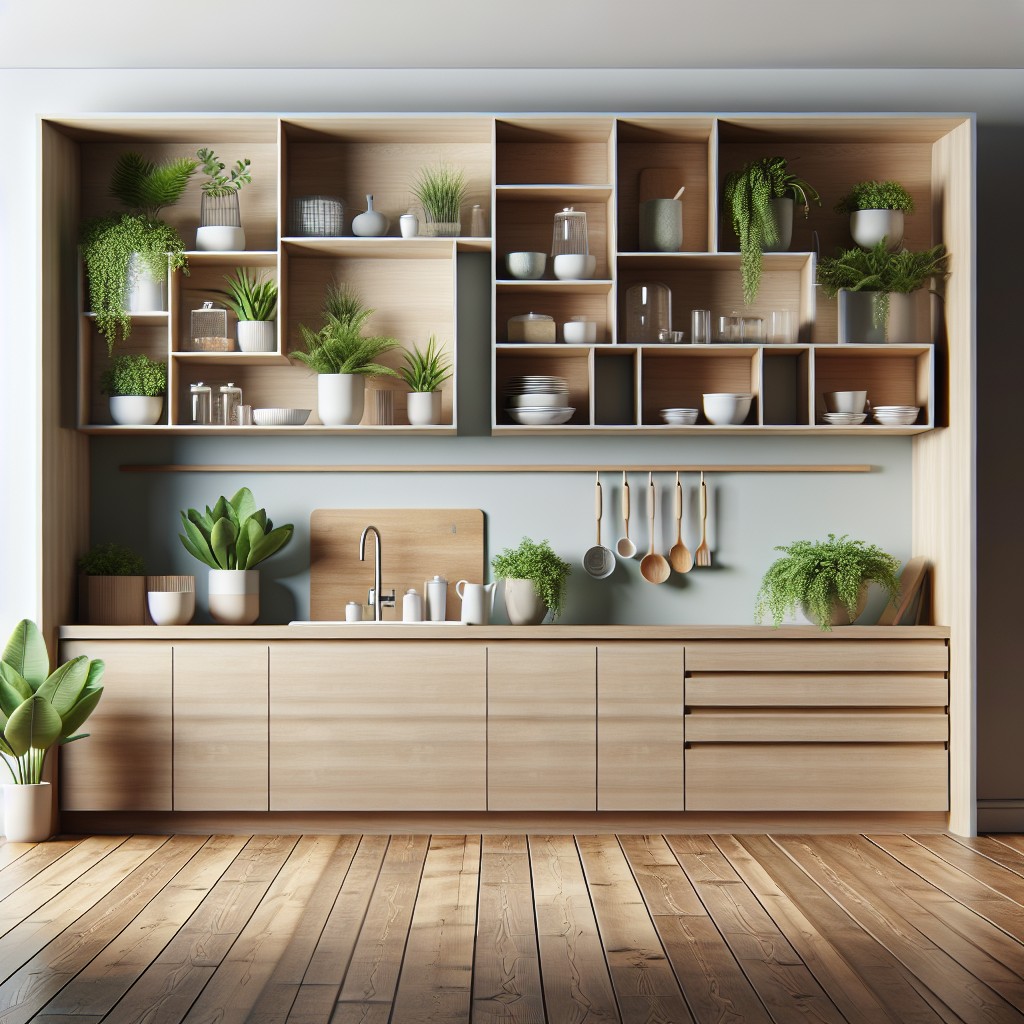Last updated on
Unleashing your home’s style potential, this comprehensive guide offers streamlined techniques for modernizing that space above your kitchen cabinets.
Key takeaways:
- Assess clearance space and dimensions for appropriate decor
- Incorporate sleek, minimalist objects for a modern aesthetic
- Choose a color scheme that harmonizes with existing hues
- Utilize negative space effectively for a balanced look
- Balance height and proportion with groupings, scaling, and layering
What's Inside
Assessing Your Space

Before transforming the area above your kitchen cabinets, it’s vital to take note of the dimensions you’re working with. The height between your cabinetry and the ceiling can determine if tall, dramatic art pieces can fit or if a series of smaller items would be more appropriate.
Measure the clearance space, considering any crown molding or varying ceiling heights. Snapshot the blank space with your phone—a visual reference will be handy while shopping for decor. Additionally, consider the depth of the cabinets; this will help you choose items that neither look dwarfed nor hang precariously off the edge.
When assessing, also clock the amount of natural light as this can influence the color and material choice of your décor—glossy finishes can reflect light and brighten a space, while darker hues might absorb light and demand stronger artificial lighting to stand out.
Be observant about existing hardware and finishes. Cohesion with metals like cabinet handles or fixtures can create a seamless look, ensuring your new decor feels integral to the kitchen rather than an afterthought.
Finally, don’t overlook what lies below. Decorations should complement not only the wall space but also the cabinet content. Clear glass-fronted cabinets may call for subtler decor, while solid doors allow for bolder above-cabinet statements.
Maintaining a Modern Aesthetic
To elevate your space with contemporary flair, incorporate sleek, streamlined objects that reflect a minimalist ethos. Think simple geometric shapes and metallic or glass accents that catch the light and create a sense of openness. Art pieces in monochromatic hues or abstract designs can add a touch of sophistication without overwhelming the area.
Opt for one or two statement items rather than a cluster of smaller decorations; a striking sculptural piece or a bold piece of modern art can serve as a focal point. If greenery is your preference, select plants with architectural qualities, like snake plants or succulents, and house them in uncomplicated, clean-lined pots.
Remember, in modern design, less is often more, so resist the temptation to fill every inch of space. The intentionality behind each piece will speak volumes to your modern aesthetic and ensure the area feels deliberate and thoughtfully curated.
Choosing a Color Scheme
Harmony with existing hues is crucial. Opt for shades complementary to your current palette or kitchen finishes for a cohesive look. Where stainless steel or neutral tones dominate, consider a monochromatic scheme with textural variations to add interest without overwhelming.
Think contrast for impact. If your kitchen is swathed in light colors, dark-toned decor can create a striking visual pop. Conversely, a collection of lighter objects can soften a kitchen with darker finishes.
Infuse vibrancy with accent colors. Pick accessories that bring a dash of bold color to energize the space. Items like vases, decorative dishes, or even a series of colorful cookbooks can serve this purpose beautifully.
Mind the undertones. Ensure the chosen decorations have undertones that align with the rest of the kitchen. For example, if your cabinets have a warm undertone, stick with warm-colored accessories—cool with cool.
Utilize metallics for sophistication. Gold, silver, or copper elements can bring a luxurious touch to the modern kitchen, pairing well with various color schemes while offering a timeless appeal.
Remember, the goal is to complement, not compete. The tones you choose should make the space feel intentional and polished, not cluttered or mismatched.
Utilizing Negative Space Effectively
Negative space, the area around and between objects, is a crucial element in modern design. It allows the room to breathe and helps to avoid a cluttered look.
1. Embrace simplicity by selecting a few large statement pieces rather than crowding the space with numerous items. A well-chosen sculpture or a series of tall, elegant vases can create a focal point.
2. Use symmetry to your advantage. Placing identical items on each side of the space can create a harmonious and ordered appearance, keeping to a minimalistic theme.
3. Consider installing accent lighting, such as LED strips or puck lights, to highlight the negative space and create a soft ambiance.
4. Stick to clean lines and geometric shapes. A series of simple square or rectangular boxes can serve as minimalistic decor while honoring the modern aesthetic.
5. Allow for the wall color to show through. If you’ve chosen a bold or interesting paint color, letting it serve as part of the decor can be a powerful design statement in itself.
By thoughtfully curating items and paying attention to the voids they create, you can achieve a balanced, modern look that feels both intentional and inviting.
Balancing Height and Proportion
When adorning the space above your kitchen cabinets, it’s crucial to keep proportion in mind. Too many small items will look cluttered, while a few oversized pieces might dominate and overwhelm the space. Consider these tips for a balanced approach:
1. Groupings: Cluster items of varying heights together, creating visually appealing vignettes. This helps the eye move smoothly across the display.
2. Scaling: Select decor that’s appropriately sized for the space. A single large statement piece, like a vase or sculptural element, can serve as a focal point without crowding the area.
3. Layering: Think in terms of depth. Layering items, with taller pieces at the back and shorter ones in front, creates depth and interest.
4. Rhythm: Establish a rhythm by repeating elements with a consistent color or texture at intervals. This creates a sense of harmony and order.
By focusing on these aspects, you’ll create a display that complements the modern kitchen’s design, subtly enhancing the room’s overall ambiance.




